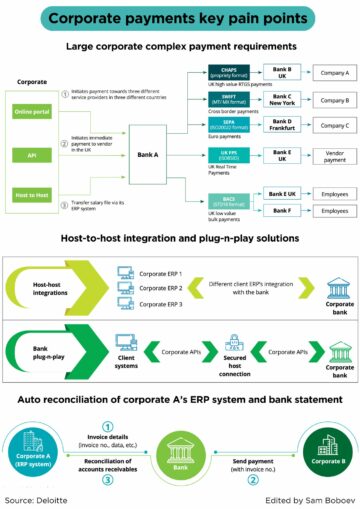
More than fifty years ago, SAP pioneered the concept of Enterprise Resource Planning (ERP) for manufacturing. The concept was simple: a single platform with a single data model to support shared services (i.e., HR, Finance, Procurement) and core business functionality (i.e., Planning, Operations, Inventory, etc.). The concept took off, especially as organizations looked to cope with software limitations of Y2K and modernize their operations. Benefits included a more complete and consistent view of the organization along with actionable insights to make intelligent business decisions (i.e., “The Intelligent Enterprise”). It was no surprise that the model was adopted in manufacturing-centric sectors and then spread to other industries looking to benefit from frictionless processes and consistent, readily available management information.
With complex business processes and many subject to strict time constraints, Mortgage Lending also can be well served with the same “ERP Concepts” that are benefitting other industries like manufacturing, energy, resources, retail, hospitality, etc. Leveraging a common data model across loan pre-qualification, originations, fulfillment, servicing and default management can break down the organizational silos that exist across most mortgage companies.
Organizationally, many mortgage lenders, especially large commercial banks that both originate and service loans, run their operations as separate profit and loss centers, with distinct operational hierarchies. Technology decisions are made unilaterally for each business, in part because there is no marketplace software offering that serves both origination and servicing functions. The commercial terms for licensing software are also different for each segment. Origination software licenses range from 3 – 5-year terms, whereas servicing subscriptions can be 5 – 10-year commitments. There is considerable value in placing both discrete processes on a common platform to optimize value over the life of loans.
One of the anomalies in mortgage lending is that 78% of borrowers will refinance their primary residences with different lenders than the ones they used to get their initial mortgages. Most loan officers lack real-time consumable customer information to anticipate when their customers are likely to need new mortgages. The top complaint of originators is that they do not have access to borrower data. Many loan officers grow their businesses by acquiring or soliciting leads from external sources; this results in the cannibalization of other loan officers’ existing, profitable books. Lenders lose business every day because of an inability to accurately and efficiently utilize business insights and data to proactively market new origination products to existing customers.
A common mortgage platform creates a view into individual and portfolio loan attribute risk modeling. As market dynamics influence borrower incomes, cash flows, real estate property values, insurance rates, taxes, etc., the ability to use risk-based modeling to proactively evaluate loan level action (e.g., refinance, modification, program change, asset sale, retention strategies) is a mitigant to default and portfolio value erosion.
One of the most beneficial aspects of a single ERP platform is the unification or “containerization” of business process micro-services onto a single UI and data layer. This reduces the scope of individual software solutions that must be deployed, integrated and maintained by trained professional system administrators which has a dramatic impact on total cost of ownership (e.g., licensing, testing, QA, maintenance, release management).
Mortgage companies should seriously consider leveraging better manufacturing technology systems to originate and service mortgages. The benefits of modernizing decades-old, legacy technologies with next-generation manufacturing software are:
- streamlining training and employee onboarding
- simplifying access to customer and loan data
- reducing costs per loan and enhancing customer profitability
- improving borrower retention
- reducing defects and communicating better with investors
Having spent three decades in financial services working with legacy and emerging mortgage technologies on behalf of mortgage banks, servicers and government-sponsored enterprises, I’ve seen these challenges and perceived risks from several perspectives. The underlying platforms that currently support U.S. mortgages are ripe for disruption. With the current market headwinds of rising interest rates and reduced overall transaction volumes, margin compression is the single most critical top-of-mind concern for mortgage industry executives. This type of market stress makes it the right time to evaluate alternatives to aging systems.
What are your challenges with handling mortgage loans and their underlying technologies?
- SEO Powered Content & PR Distribution. Get Amplified Today.
- PlatoData.Network Vertical Generative Ai. Empower Yourself. Access Here.
- PlatoAiStream. Web3 Intelligence. Knowledge Amplified. Access Here.
- PlatoESG. Automotive / EVs, Carbon, CleanTech, Energy, Environment, Solar, Waste Management. Access Here.
- PlatoHealth. Biotech and Clinical Trials Intelligence. Access Here.
- ChartPrime. Elevate your Trading Game with ChartPrime. Access Here.
- BlockOffsets. Modernizing Environmental Offset Ownership. Access Here.
- Source: https://www.finextra.com/blogposting/24862/why-mortgage-lenders-need-to-consider-the-power-of-erp-for-loan-lifecycle-management?utm_medium=rssfinextra&utm_source=finextrablogs
- :has
- :is
- :not
- a
- ability
- access
- accurately
- acquiring
- across
- Action
- administrators
- adopted
- Aging
- ago
- along
- also
- alternatives
- an
- and
- anticipate
- ARE
- AS
- aspects
- asset
- available
- Banks
- BE
- because
- behalf
- beneficial
- benefit
- benefits
- benefitting
- Better
- Books
- borrower
- borrowers
- both
- Break
- business
- Business Process
- business processes
- businesses
- by
- CAN
- Cash
- Centers
- challenges
- change
- commercial
- commitments
- Common
- communicating
- Companies
- complaint
- complete
- complex
- concept
- Concern
- Consider
- considerable
- consistent
- constraints
- Core
- Cost
- Costs
- creates
- critical
- Current
- Currently
- customer
- customer information
- Customers
- data
- day
- decades
- decisions
- Default
- deployed
- different
- Disruption
- distinct
- do
- down
- dramatic
- dynamics
- e
- each
- efficiently
- emerging
- Employee
- energy
- enhancing
- Enterprise
- enterprises
- ERP
- especially
- estate
- etc
- evaluate
- Every
- every day
- executives
- exist
- existing
- external
- fifty years
- finance
- financial
- financial services
- Finextra
- Flows
- For
- frictionless
- from
- fulfillment
- functionality
- functions
- get
- Grow
- Handling
- Have
- headwinds
- hospitality
- hr
- HTTPS
- i
- Impact
- in
- inability
- included
- individual
- industries
- industry
- influence
- information
- initial
- insights
- insurance
- integrated
- Intelligent
- interest
- Interest Rates
- into
- inventory
- Investors
- IT
- jpg
- Lack
- large
- layer
- Leads
- Legacy
- lenders
- lending
- Level
- leveraging
- licenses
- Licensing
- Life
- lifecycle
- like
- likely
- limitations
- loan
- Loans
- looked
- looking
- lose
- loss
- made
- maintenance
- make
- MAKES
- management
- manufacturing
- many
- Margin
- Market
- marketplace
- model
- modeling
- modernize
- modernizing
- more
- Mortgage
- Mortgages
- most
- must
- Need
- New
- next-generation
- no
- of
- off
- offering
- officers
- on
- Onboarding
- ones
- onto
- operational
- Operations
- Optimize
- or
- organization
- organizational
- organizations
- origination
- originations
- originators
- Other
- over
- overall
- ownership
- part
- per
- perceived
- perspectives
- pioneered
- placing
- planning
- platform
- Platforms
- plato
- Plato Data Intelligence
- PlatoData
- portfolio
- power
- primary
- process
- processes
- procurement
- Products
- professional
- Profit
- profitability
- profitable
- Program
- property
- Q&A
- range
- Rates
- real
- real estate
- real-time
- Reduced
- reduces
- release
- resource
- Resources
- Results
- retail
- retention
- right
- rising
- Risk
- risks
- Run
- s
- sale
- same
- sap
- scope
- Sectors
- seen
- segment
- separate
- seriously
- serves
- service
- Services
- several
- shared
- should
- silos
- Simple
- single
- Software
- Solutions
- Sources
- spent
- spread
- strategies
- stress
- strict
- subject
- subscriptions
- support
- surprise
- system
- Systems
- Taxes
- Technologies
- Technology
- terms
- Testing
- than
- that
- The
- their
- then
- There.
- These
- they
- this
- three
- time
- to
- took
- top
- Total
- trained
- Training
- transaction
- type
- u.s.
- ui
- underlying
- use
- used
- utilize
- value
- Values
- View
- volumes
- was
- WELL
- when
- whereas
- which
- why
- will
- with
- working
- years
- Your
- zephyrnet












